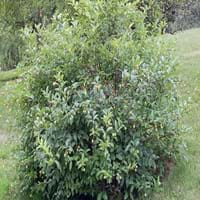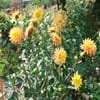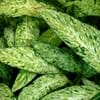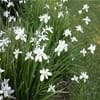Life Span
Annual
Annual and Perennial
Type
Tender Perennial
Shrub
Origin
Hybrid origin
South Africa
Types
Gabrielle Marie, Brittany Rey
Not Available
Number of Varieties
Not Available
Habitat
Mountains, Upland
Boggy areas, Dappled Shade, Shady Edge, Sunny Edge, Woodland Garden Canopy
USDA Hardiness Zone
8-11
9-11
Sunset Zone
H1, 1a, 1b, 2a, 2b, 3a, 3b, 4, 5, 6, 7, 8, 9, 10, 11, 12, 13, 14, 15, 16, 17, 18, 19, 20, 21, 22, 23, 24
H1, 14, 15, 16, 17, 18, 19, 20, 21, 22, 23, 24
Habit
Clump-Forming
Upright/Erect
Flower Color
Light Pink, Rose, Salmon, Ivory
Light Yellow, Ivory
Flower Color Modifier
Bicolor
Not Available
Fruit Color
Not Available
Brown
Leaf Color in Spring
Green
Green
Leaf Color in Summer
Green
Green
Leaf Color in Fall
Green
Green
Leaf Color in Winter
Light Green
Green
Leaf Shape
Arrowhead
Egg-shaped
Plant Season
Spring, Summer, Fall
Spring, Summer, Fall, Winter
Sunlight
Full Sun
Full Sun, Partial Sun
Type of Soil
Loam, Sand
Loam, Sand
The pH of Soil
Neutral
Acidic, Neutral
Soil Drainage
Well drained
Average
Bloom Time
Indeterminate
Early Spring, Spring, Late Spring, Winter, Late Winter
Tolerances
Drought
Wet Site
Where to Plant?
Container, Ground, Pot
Ground, Pot
How to Plant?
From bulbs
Seedlings, Stem Cutting
Plant Maintenance
Medium
Medium
Watering Requirements
Never Over-water, Requires regular watering, Requires watering in the growing season, Water Deeply, Water more in summer
Requires 4 to 8 inches of water above the soil line
In Summer
Lots of watering
Lots of watering
In Spring
Moderate
Moderate
In Winter
Average Water
Average Water
Soil pH
Acidic, Neutral
Acidic, Neutral
Soil Type
Clay, Loam, Sand
Loam, Sand
Soil Drainage Capacity
Well drained
Average
Sun Exposure
Full Sun, Partial Sun
Full Sun, Partial Sun
Pruning
Remove damaged leaves, Remove dead branches, Remove dead leaves
Prune in early summer, Remove damaged leaves, Remove dead branches, Remove dead leaves, Trim each shoot back to the first set of leaves
Fertilizers
fertilize every 2-3 weeks while growing
All-Purpose Liquid Fertilizer
Pests and Diseases
Red blotch
Red blotch
Plant Tolerance
Drought
Wet Site
Flower Petal Number
Not Available
Not Available
Fragrant Flower
Yes
Not Available
Fragrant Leaf
No
Not Available
Fragrant Bark/Stem
No
Not Available
Foliage Texture
Medium
Fine
Foliage Sheen
Matte
Matte
Attracts
Butterflies, Insects
Butterflies
Allergy
Eczema, Skin irritation, Skin rash
Toxic
Aesthetic Uses
Not Available
Showy Purposes
Beauty Benefits
Not Available
Not Available
Environmental Uses
Air purification, Food for animals, Food for insects
Air purification
Medicinal Uses
Kidney problems
Astringent, Diaphoretic, Diuretic, Emetic, Febrifuge, Laxative, Odontalgic, Ophthalmic, Tonic
Part of Plant Used
Bulbs, Flowers
Bark, Fruits, Inner Bark, Root, Wood
Other Uses
Decoration Purposes, Economic Purpose, Showy Purposes, Used As Food, Used as Ornamental plant
Used for woodware
Used As Indoor Plant
Yes
No
Used As Outdoor Plant
Yes
Yes
Garden Design
Bedding Plant, Container, Cutflower, Edging, Mixed Border
Bog Garden, Cutflower, Dried Flower, Everlasting, Feature Plant, Mixed Border, Tropical
Botanical Name
DAHLIA 'Gallery Salvador'
BERZELIA lanuginosa
Common Name
Dahlia, Decorative Dahlia, Gallery Salvador Dahlia
Buttonbush
In Hindi
मेक्सिको का रंगीन फूलों का बड़ा पौधा
Buttonbush shrub
In German
Dahlie
Button Strauch
In French
Dahlia
buttonbush arbuste
In Spanish
Dalia
arbusto buttonbush
In Greek
Ντάλια
Buttonbush θάμνος
In Portuguese
Dália
arbusto Buttonbush
In Polish
Dalia
Buttonbush krzew
In Latin
Dahlia
Frutex Buttonbush
Phylum
Tracheophyta
Magnoliophyta
Class
Magnoliopsida
Magnoliopsida
Family
Asteraceae
Bruniaceae
Genus
Dahlia
Cephalanthus
Clade
Angiosperms, Asterids, Eudicots
Angiosperms, Asterids, Eudicots
Tribe
Coreopsideae
Not Available
Subfamily
Asteroideae
Not Available
Season and Care of Dahlia and Buttonbush
Season and care of Dahlia and Buttonbush is important to know. While considering everything about Dahlia and Buttonbush Care, growing season is an essential factor. Dahlia season is Spring, Summer and Fall and Buttonbush season is Spring, Summer and Fall. The type of soil for Dahlia is Loam, Sand and for Buttonbush is Loam, Sand while the PH of soil for Dahlia is Neutral and for Buttonbush is Acidic, Neutral.
Dahlia and Buttonbush Physical Information
Dahlia and Buttonbush physical information is very important for comparison. Dahlia height is 30.50 cm and width 30.50 cm whereas Buttonbush height is 365.76 cm and width 182.88 cm. The color specification of Dahlia and Buttonbush are as follows:
Dahlia flower color: Light Pink, Rose, Salmon and Ivory
Dahlia leaf color: Green
Buttonbush flower color: Light Yellow and Ivory
- Buttonbush leaf color: Green
Care of Dahlia and Buttonbush
Care of Dahlia and Buttonbush include pruning, fertilizers, watering etc. Dahlia pruning is done Remove damaged leaves, Remove dead branches and Remove dead leaves and Buttonbush pruning is done Prune in early summer, Remove damaged leaves, Remove dead branches, Remove dead leaves and Trim each shoot back to the first set of leaves. In summer Dahlia needs Lots of watering and in winter, it needs Average Water. Whereas, in summer Buttonbush needs Lots of watering and in winter, it needs Average Water.





